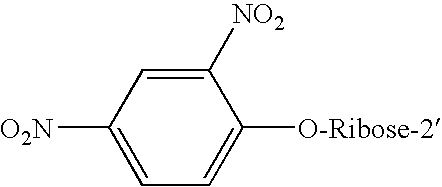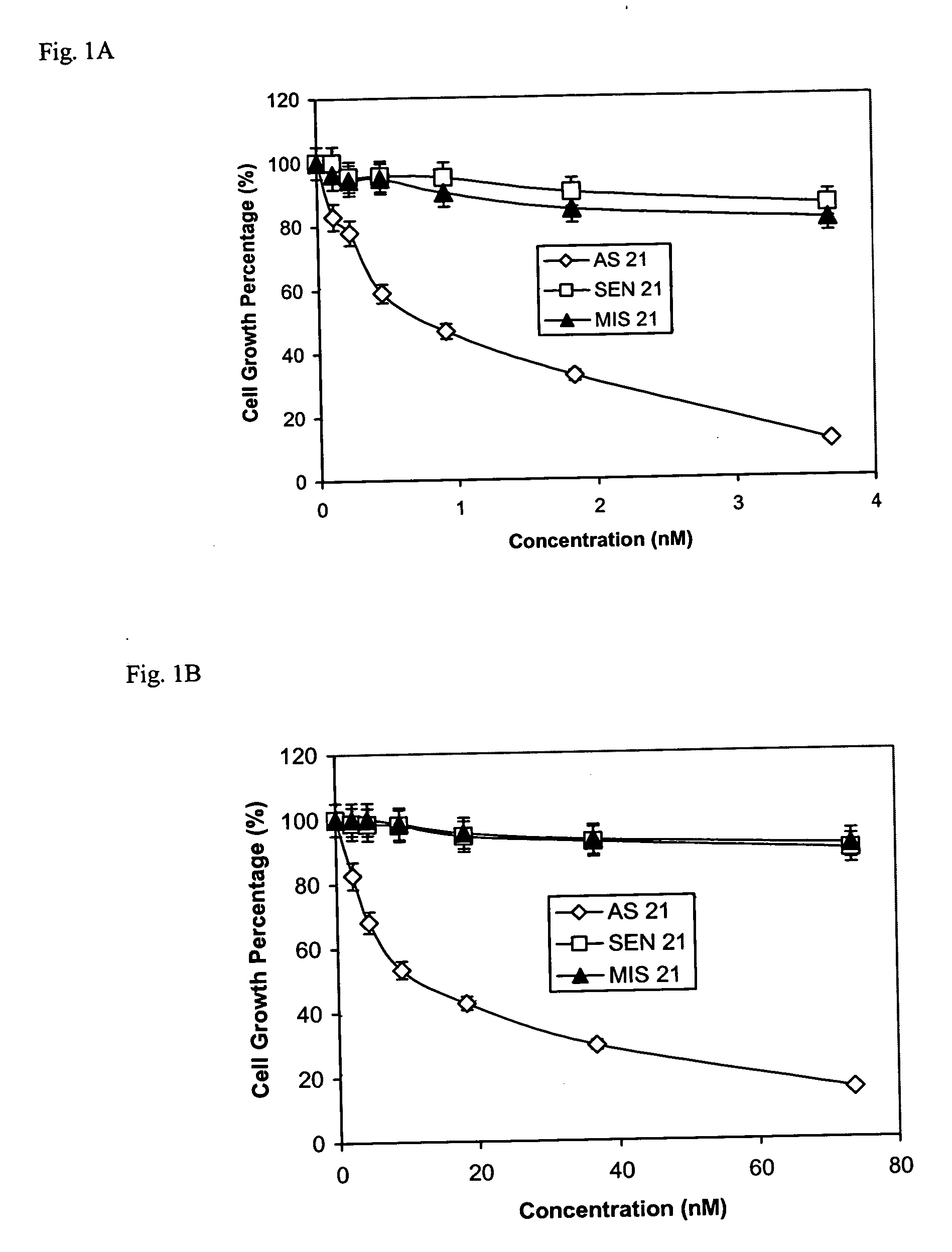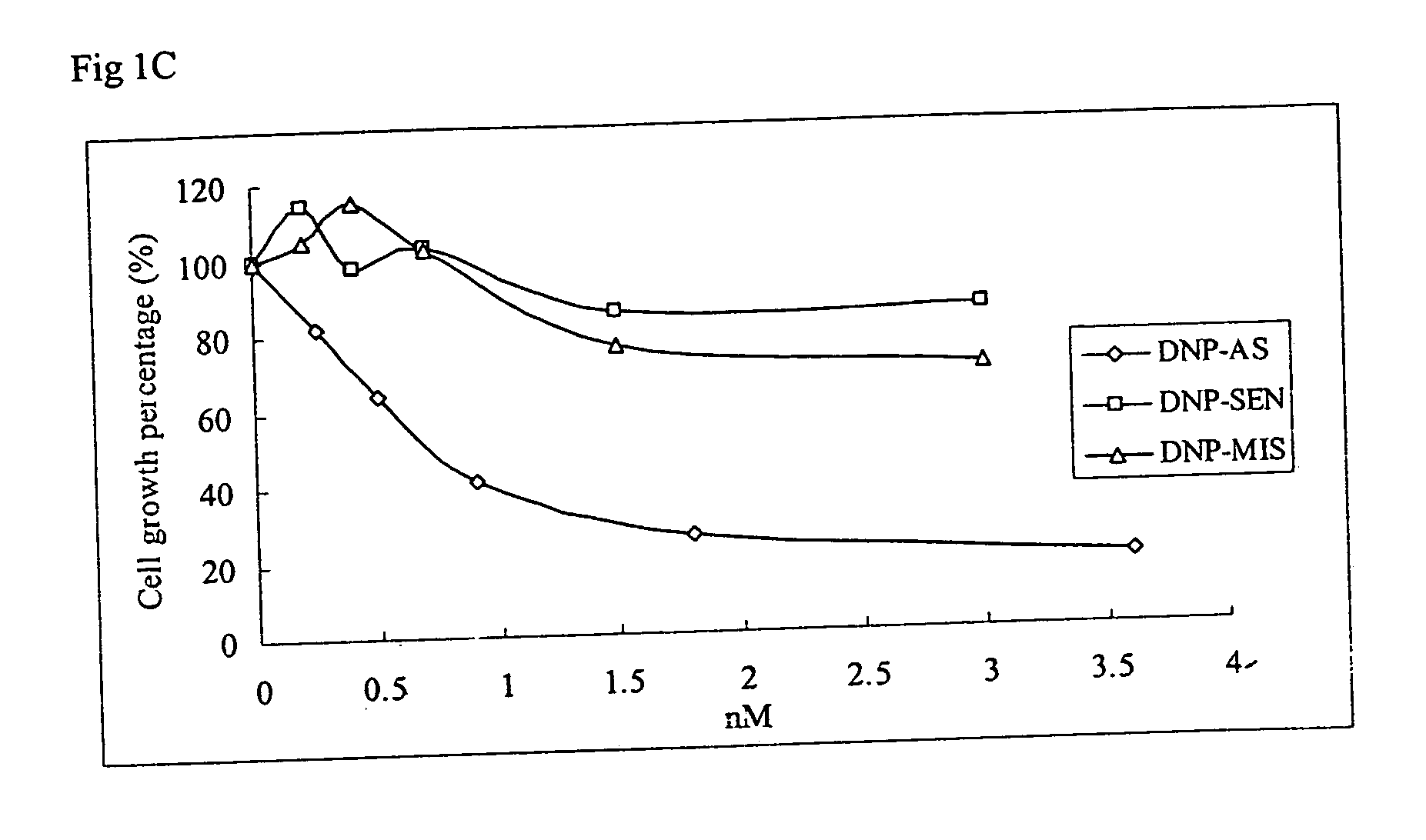In Vitro and in vivo silencing of human c-myc oncogene expression by poly-DNP-RNA
a technology of c-myc and oncogene, applied in the field of antisense polydnp oligonucleotides, can solve the problems of unsatisfactory attempt to replace the phosphorothioate backbone with the phosphorodiamidate morpholino backbone, unsatisfactory specific sequence-dependent side effects, etc., and achieve high efficacy and sequence specificity
- Summary
- Abstract
- Description
- Claims
- Application Information
AI Technical Summary
Benefits of technology
Problems solved by technology
Method used
Image
Examples
example 1
[0042] This Example describes the preparation and derivatization of the antisense RNA oligoribonucleotides of the invention. The DNP-RNA sequences in Table 1 were synthesized as previously described (31). In brief, RNA was first synthesized by in vitro transcription, using a promoter-containing DNA-template and T7 polymerase, followed by reaction with 2,4-dinitro-1-flurobenzene under controlled conditions. To characterize the DNP-RNAs, the molar DNP / nucleotide ratio (˜0.7) and the actual concentration of DNP-RNAs were calculated from the observed absorbance at 260 and 330 nm because the oligonucleotide has absorbance only at 260 nm, whereas the DNP has absorbance at both wavelengths. The purity of poly-DNP-RNAs was determined by running the samples on 16% denaturing PAGE gels. The sequence of the poly-DNP oligoribonucleotides used in this invention is presented in Table 1, wherein each bolded and italicized base represents a mismatch. The first G at the 5′-end of SEN-21 was added to...
example 2
[0043] This Example demonstrates the specific inhibition of cancer cell growth using the oligoribonucleotide of the invention. We used three well established cancer cell lines, MCF-7 human breast cancer cells, A549 human lung adenocarcinoma cells, and Colo829 human melanoma cells purchased from ATCC (Rockville, Md.), to test the efficacy of DNP-RNAs. MCF-7 human breast cancer cells were grown in Minimum Essential Medium (MEM) a Medium supplemented with 10% fetal bovine serum (FBS) (Invitrogen, Carlsbad, Calif.) and Insulin (5 mg / ml) (Sigma, St. Louis, Mo.). A549 human lung adenocarcinoma cells were grown in F-12 Nutrient Mixture (Ham) supplemented with 10% FBS (Invitrogen). Colo829 human melanoma cells were grown in RPMI1640 medium (ATCC, Rockville, Md.). Cells were grown in a humidified atmosphere of 95% air and 5% CO2 at 37° C.
[0044] To perform cell proliferation assays, OLIGOFECTAMINE™ reagent (GIBCO-BRL) was used to increase the delivery of poly-DNP-RNA into cells in culture. A...
example 3
[0048] In this Example, the effect on c-myc mRNA expression of an oligoribonucleotide with complete complementarity to the c-myc iRNA was compared with the effect of oligoribonucleotides having bases mismatched for the c-myc mRNA sequence. Specifically, total RNA was isolated from MCF-7 cells treated with different the DNP-RNAs listed in Table 1 and assayed by both RT-PCR and Real-Time RT-PCR.
[0049] To prepare total RNA and perform RT-PCR, MCF-7 cells (2×105 / well) were plated in 6-well plates one day before being treated with 100 nM DNP-RNAs in the presence of OLIGOFECTAMINE. After incubation of the cells with poly-DNP-RNAs for 24 h, the cells were lysed and total RNAs were extracted using RNeasy Mini Kit (Qiagen, Valencia, Calif.). The subsequent reverse transcription was carried out in the presence 2 μl Oligo (dT)12-18 (500 μg / ml) primer, reaction buffer, 0.5 mM dNTP Mix, 10 mM DTT (Invitrogen), 2 U / μl RNasin® Ribonuclease inhibitor(Promega), and 20 U / μl M-MLV reverse transcripta...
PUM
| Property | Measurement | Unit |
|---|---|---|
| Volume | aaaaa | aaaaa |
| Volume | aaaaa | aaaaa |
| Volume | aaaaa | aaaaa |
Abstract
Description
Claims
Application Information
 Login to View More
Login to View More - R&D
- Intellectual Property
- Life Sciences
- Materials
- Tech Scout
- Unparalleled Data Quality
- Higher Quality Content
- 60% Fewer Hallucinations
Browse by: Latest US Patents, China's latest patents, Technical Efficacy Thesaurus, Application Domain, Technology Topic, Popular Technical Reports.
© 2025 PatSnap. All rights reserved.Legal|Privacy policy|Modern Slavery Act Transparency Statement|Sitemap|About US| Contact US: help@patsnap.com



